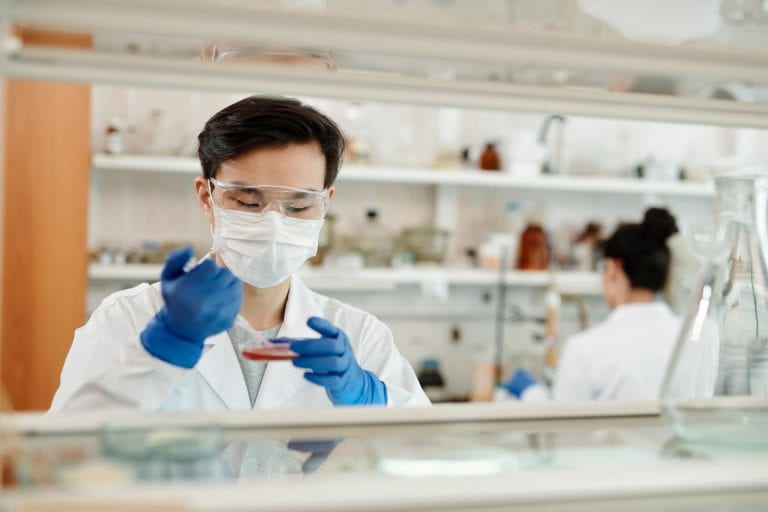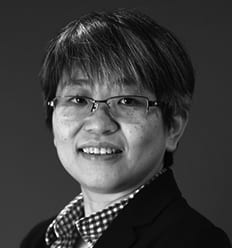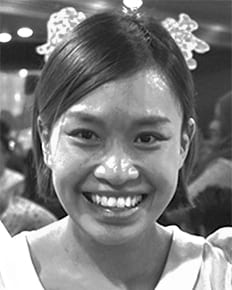YEONG Foong May, LEE Zheng Wei, CHEW Yuanyuan, and LEE Seow Chong
Department of Biochemistry,
Yong Loo Lin School of Medicine (YLLSoM)
Foong May, Zheng Wei, Yuanyuan, and Seow Chong discuss how they produced videos of fundamental laboratory techniques using available equipment such as mobile phones and free video editing software.

We had recently planned during the semester break to film videos of our laboratory techniques for our third-year practical-based modules. These videos, based on our intended learning outcomes, would demonstrate fundamental techniques students can review before and after practicals. While use of videos for laboratory demonstrations is not new (Pearlman, Cummings, Shingles, Maldarelli, Horner, Hartmann, & Obom, 2009), we have not seen them used in our context.
In mid-February 2020, we anticipated that the COVID-19 outbreak could disrupt practical classes. We brought forward plans to make the videos and finalised a list of videos on fundamental laboratory techniques.
We did not have sophisticated video equipment, so we decided to improvise and use whatever was available to us.
- We shot our first video using ambient lighting in the laboratory and a hand-held iPhone attached to an external microphone.
- To test if it was possible to film a microbiological technique called the anti-microbial susceptibility test, we simulated the procedure using an old agar plate, some agarose heated up using the microwave oven, an old anti-microbial strip and leftover overnight yeast culture.
- To illustrate the results of the experiment, a recently completed E-test plate we had kept in the refrigerator came in handy.
- Once the filming was completed, we edited our raw recording using a free video-editing software called iMovie. This meant making simple voice-over editing, adding subtitles or labels, and zooming in on the relevant steps throughout the laboratory procedure. The result, we thought, was decent and conveyed the lesson we wanted our students to learn (click on Figure 1 to view the video).

Figure 1. Video recording of the anti-microbial susceptibility test.
Photo courtesy of YEONG Foong May
It is therefore possible to do demo video recordings using what we have on hand—ambient light in the laboratory, a handphone supported by a less-than-$40 tripod and simulated experimental reagents, which is similar to simulations used in clinical teaching (Murray, Grant, Howarth, & Leigh, 2008). A few additional points to consider:
- Have an alignment guide to decide what aspects of the demonstrations are relevant and plan out the sequence of the experiments.
- Use simulation to replace actual reagents or other setup that cannot be distinguished from the actual setup on videos to make full use of existing resources. An example of a simulated reagent is most obvious in this video where we used coloured food dye instead of actual reagents, which are typically colourless, to clearly demonstrate the concept of serial dilutions.
- Use what is available for making the videos, such as the handphone camera and free video editing software.
- Decide on the editing and format needed for specific videos:
 | Simple trimming and splicing of raw videos. This should be performed to extract relevant sections of the recording so that the videos are succinct. |
 | Voice-overs. This might be needed if there are background noises or specific learning points to be included. |
 | Picture-in-picture. An example of a more complicated video was when we wanted to demonstrate a liquid-handling dispensing Robot in action while being controlled by a dedicated software. To film this, the iPhone was set up to record the Robot in action. Meanwhile, we used QuickTime for the screen recording, which was set up simultaneously on the laptop controlling the Robot to show the steps executed in the software. During post-production, the two videos were synchronised simply by listening to the audio recorded on both the iPhone and the screen recording. Click on Figure 2 for an example of such a video. Photo courtesy of YEONG Foong May |
As we looked through and reflected on our videos, we found that we could improve on several aspects of the process to further enhance learning, including:
- uploading the videos before practicals so that students could prepare before class
- incorporating in-video questions to engage students
- using the videos for assessment purposes
In conclusion, we suggest that at times, it is possible to use what we have on hand to produce videos to demonstrate laboratory techniques. This would mean tapping on our creativity and problem-solving skills that we often want our students to demonstrate!
 |
YEONG Foong May is Associate Professor at the Department of Biochemistry, National University of Singapore (NUS). She is a cell and molecular biologist and her interest in higher education revolves around collaborative and authentic learning. She is a Fellow of the NUS Teaching Academy, affiliate of the NUS Institute of Applied Learning Sciences and Educational Technology (NUS ALSET) and Senior Fellow of the Higher Education Academy, UK. Foong May can be reached at bchyfm@nus.edu.sg |
 |
LEE Zheng Wei is a Full-time Teaching Assistant at the Department of Biochemistry, NUS. Previously trained in cancer biology, he now teaches Life Sciences undergraduate’s practical and tutorial classes. He believes that a teacher could enhance the students’ learning by providing proper scaffolding and designing engaging teaching and learning activity. Zheng Wei can be reached at bchleez@nus.edu.sg. |
 |
CHEW Yuanyuan is a senior laboratory executive at the Department of Biochemistry, NUS. She has more than 10 year of experience in laboratory management and operation in both research and teaching laboratories. She also assists in designing and setting up practical classes for the Life Sciences undergraduates. Yuanyuan can be reached at bchchewy@nus.edu.sg |
 |
LEE Seow Chong is an Instructor at the Department of Biochemistry, NUS. He teaches practical classes to the Life Sciences undergraduates and writing classes to postgraduates. He believes in providing students with a solid foundation in science through understanding and applying the basics of scientific thinking and writing. Seow Chong can be reached at bchlees@nus.edu.sg |
References
Murray, C., Grant, M. J., Howarth, M. L., & Leigh, J. (2008). The use of simulation as a teaching and learning approach to support practice learning. Nurse Education in Practice, 8(1), 5–8. https://doi.org/10.1016/j.nepr.2007.08.001
Pearlman, R. S., Cummings, P. J., Shingles, R., Maldarelli, G. A., Horner, R. D., Hartmann, E. M., & Obom, K. M. (2009). Virtual Lab Demonstrations Improve Students’ Mastery of Basic Biology Laboratory Techniques. Journal of Microbiology & Biology Education, 10(1), 51–57. https://doi.org/10.1128/jmbe.v10.99

